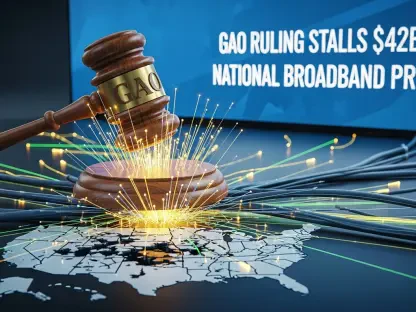In the fast-evolving world of telecommunications, Spain stands as a critical battleground where major players vie for dominance amid intense competition and regulatory scrutiny, with a single strategic move potentially reshaping the entire landscape. Imagine a market where such a move could alter consumer choices and pricing structures across the nation. This scenario is unfolding as Telefónica, a titan in the Spanish telecom sector, eyes an acquisition of Vodafone Spain, a deal that could redefine its standing in Europe. This report dives into the current state of the Spanish telecom industry, explores Telefónica’s motivations, examines the formidable regulatory challenges, and considers alternative paths forward in a broader European context of consolidation.
Overview of the Spanish Telecom Landscape
The Spanish telecommunications market is a dynamic and competitive arena, characterized by significant investments in infrastructure and a growing demand for high-speed connectivity. As one of the largest telecom markets in Europe, Spain plays a pivotal role in shaping regional trends, with its advanced 5G rollout and widespread fiber optic coverage setting benchmarks for others. Key players dominate this space, each holding substantial stakes in a market driven by innovation and customer acquisition strategies.
According to data from the Spanish competition regulator CNMC, MasOrange leads with a commanding 41% market share, followed by Telefónica’s Movistar at 26%, Vodafone Spain at 19%, and Digi at 11%. These figures highlight a fragmented yet concentrated market where strategic maneuvers can yield significant shifts in power. Digi, despite its smaller share, remains a notable contender, though its limited status as a full mobile network operator due to reliance on roaming agreements poses unique challenges.
Spain’s significance extends beyond its borders, serving as a microcosm of broader European telecom dynamics where consolidation and competition policies are fiercely debated. A recent milestone in this market was Zegona’s acquisition of Vodafone Spain for 5 billion euros in 2023, a transaction that has added layers of complexity to potential future deals. This development, among others, underscores the fluidity of ownership and strategic alignments within the sector.
Strategic Motivations Behind Telefónica’s Bid
Driving Forces for Consolidation
Telefónica, under the stewardship of CEO Marc Murtra, is pursuing an ambitious agenda to solidify its foothold in the Spanish market through strategic acquisitions. Murtra has articulated a vision of consolidation among major European telecom companies, arguing that larger entities can better invest in cutting-edge technology and enhance global competitiveness. This perspective aligns with a growing sentiment in the industry that scale is essential to meet the demands of digital transformation.
Analyst Kester Mann from CCS Insight has noted Murtra’s keen interest in positioning Telefónica as a more dominant force across Europe. Such a move would not only bolster the company’s regional influence but also provide a platform to lead innovation in areas like 5G and Internet of Things solutions. The drive toward consolidation is seen as a response to fragmented markets that often hinder the ability to fund massive infrastructure projects.
Market Opportunities and Benefits
Acquiring Vodafone Spain presents Telefónica with a unique opportunity to expand its market share from 26% to a potential combined share that could rival MasOrange’s 41%. This increase would create significant operational synergies, including cost reductions in network maintenance and customer service operations. The economies of scale achieved could enable Telefónica to offer more competitive pricing or invest further in technology upgrades.
Beyond raw numbers, the strategic benefits of such a merger include a stronger negotiating position with suppliers and content providers, essential in a market where streaming and bundled services are becoming key differentiators. Analysts suggest that consolidating operations with Vodafone Spain could equip Telefónica to navigate the rapid evolution of consumer expectations, particularly in data-intensive applications.
The potential deal also offers a chance to streamline overlapping resources, reducing redundancies in a sector where profit margins are often squeezed by high capital expenditures. If successful, this acquisition could serve as a blueprint for Telefónica’s expansion strategies in other European markets, reinforcing its role as a pacesetter in the industry.
Regulatory Challenges in the EU Telecom Sector
The European Union’s regulatory framework poses a significant barrier to telecom mergers, particularly those that reduce the number of operators in a given market. Historically, EU authorities have resisted consolidations that could diminish competition, citing concerns over reduced consumer choice and potential price hikes. This stance has shaped a cautious approach to approving large-scale deals, often requiring substantial concessions from merging entities.
A relevant precedent is the Orange-MasMovil merger in Spain, which gained approval only after extensive remedies were implemented to support Digi as a viable fourth operator. These conditions included spectrum allocations and network access agreements, designed to prevent market concentration. Such examples illustrate the depth of scrutiny Telefónica would face in pursuing Vodafone Spain, especially given the risk of shrinking the number of major players.
Karen Egan from Enders Analysis has described the regulatory hurdle as extremely high, particularly for a deal that could effectively reduce Spain’s mobile network operators from three to two. With Digi’s limited infrastructure capacity, regulators are likely to prioritize maintaining a competitive balance, making approval of a standalone acquisition by Telefónica a complex and uncertain proposition. Consumer protection remains at the heart of these deliberations, with pricing impacts under close watch.
Alternative Strategies to Navigate Obstacles
Given the regulatory headwinds, Telefónica may need to explore creative strategies to make the acquisition of Vodafone Spain feasible. One speculated approach is a joint takeover or asset carve-up with MasOrange, a move that could distribute market power more evenly and address antitrust concerns. Reports of informal discussions between the two giants, as noted by Bloomberg, suggest a possible split of Vodafone Spain’s assets, such as separating enterprise and mobile divisions.
Analysts have weighed in on the practicality of shared acquisitions, pointing out that while competition issues would still arise, a collaborative bid could be less contentious and more cost-effective than a solo effort by Telefónica. This strategy might involve intricate negotiations to ensure equitable distribution of resources, yet it could offer a pathway to regulatory approval by preserving a semblance of market diversity.
Additionally, Digi’s status as a partial mobile network operator, reliant on roaming agreements, plays a critical role in shaping regulatory perspectives. Any deal structure would likely need to include provisions to bolster Digi’s competitive position, potentially through access to spectrum or infrastructure. Crafting such arrangements could be a key factor in gaining the necessary green light from EU authorities, balancing consolidation with competition.
Broader European Trend of Telecom Consolidation
Telefónica’s interest in Vodafone Spain is not an isolated ambition but part of a continent-wide movement toward telecom consolidation. Research from Analysys Mason predicts that by the end of this year, over half of Europe’s population will reside in markets with only three operators, a shift already evident in Spain following the MasOrange merger. This trend reflects an industry push for fewer, larger players capable of sustaining heavy investments in next-generation technologies.
Parallel discussions are unfolding in other major markets, such as France, where Altice is contemplating the sale of SFR, and Italy, where TIM’s leadership advocates for mergers while facing opposition from Iliad. These cases highlight a shared recognition among telecom executives that consolidation can drive efficiency, yet they also reveal persistent regulatory resistance focused on safeguarding consumer interests.
The tension between industry goals and policy priorities continues to define the European telecom landscape. While companies argue that larger entities can better fund innovation and infrastructure, regulators remain vigilant about the risks of reduced competition. This ongoing debate will likely influence the outcome of Telefónica’s aspirations in Spain, situating the potential deal within a broader narrative of transformation and contention.
Conclusion and Future Outlook
Reflecting on the intricate dynamics that have unfolded in the Spanish telecom sector, it becomes evident that Telefónica’s pursuit of Vodafone Spain is driven by a compelling vision for market leadership and operational strength. The regulatory landscape, marked by stringent EU oversight, presents formidable challenges that test the boundaries of corporate strategy. Alternative approaches, such as potential collaborations with MasOrange, emerge as critical considerations in navigating these obstacles.
Looking ahead, stakeholders should prioritize innovative deal structures that address competition concerns while enabling necessary consolidation. Engaging with regulators early to propose remedies, such as supporting smaller operators like Digi through infrastructure access, could pave the way for approvals. Additionally, monitoring Zegona’s stance on a potential sale will be crucial, as their decision holds the key to unlocking this transformative opportunity.
Ultimately, the path forward demands a delicate balance between Telefónica’s ambitions and the imperative to protect consumer interests. Industry leaders must advocate for policies that foster investment in technology without compromising market diversity. By focusing on collaborative solutions and transparent dialogue with authorities, the Spanish telecom market can evolve into a model of sustainable growth and innovation for the broader European region.









